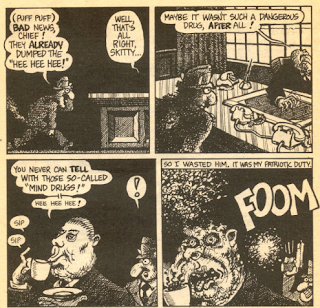Comic Books: A Time Capsule
The classic comic book is not only a presentation of art and storytelling, but is a perfectly preserved (if a little unintentionally dated) time capsule of the period in which they were made. Written words alone can tell us about the time, but something about the detached form of written word doesn't do justice to the period in which the piece was written. Comics get around this issue by being such a visual medium, and the most obvious way for a viewer to understand a time period is by the visuals.
As we discussed in class previously, the issues of sexism and racism ran rampant in comics produced throughout the early days of its medium, in both the strip and book forms. This is because those ideas and ideologies were so prevalent in the culture of the time. Themes and social issues aren't the only ways to understand a different time, but also in the way characters look. Even in comics that were much more simplistic or poorly drawn, you can see the standards for beauty and what people wore at the time. Written text alone can portray this, sometimes, but most good fiction/non-fiction spends very little time describing such idle details.
A practical example of this in action would be a comic like Dick Tracy. The comic premiered in 1931, and its main character is that of the ideal man at the time. His jaw is literally a square at most times, dark hair, pale skin, and well built. He's brave and intelligent and very much what men were supposed to be. While these are still traits considered valuable today, they are far less strict today as they were in the 30's.
As we discussed in class previously, the issues of sexism and racism ran rampant in comics produced throughout the early days of its medium, in both the strip and book forms. This is because those ideas and ideologies were so prevalent in the culture of the time. Themes and social issues aren't the only ways to understand a different time, but also in the way characters look. Even in comics that were much more simplistic or poorly drawn, you can see the standards for beauty and what people wore at the time. Written text alone can portray this, sometimes, but most good fiction/non-fiction spends very little time describing such idle details.
A practical example of this in action would be a comic like Dick Tracy. The comic premiered in 1931, and its main character is that of the ideal man at the time. His jaw is literally a square at most times, dark hair, pale skin, and well built. He's brave and intelligent and very much what men were supposed to be. While these are still traits considered valuable today, they are far less strict today as they were in the 30's.



Comments
Post a Comment